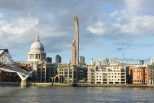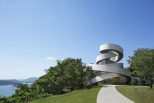Fulton Center, an impressive glass and steel building dominated by a huge transparent dome Designed by Grimshaw and Arup…

In Jiye, Lebanon, a home created for wellness and care of the body, integrated like a single organism in a large, exclusive spa. Architecture designed as part of the host landscape, inserted as a residential element in a careful compositional organization of water and gardens, trees and views of the sea.
 For Vladimir Djurovic, architectural design is, first of all, a process of listening, of integration with the landscape. In spite of the absence of practices of camouflage, and the orientation toward clear signs, simple and essential forms, precise materials, few in number, usually natural in character, the works of this rigorous, talented contemporary landscape designer are rooted in the tradition and history of the Mediterranean landscape, seen as a complex cultural context and a dialectical process in which forms meet in pursuit of harmony. The designs by Djurovic, his beautiful swimming pools, are clear cuts in the horizon, in this case framing the sea, becoming outstanding features of connection capable of blending the architecture into the host setting. From this viewpoint the design of this exclusive home immersed in greenery, facing the sea, is a good example of a modus operandi open to different solutions but connected to principles of reference that can be repeated case by case.
For Vladimir Djurovic, architectural design is, first of all, a process of listening, of integration with the landscape. In spite of the absence of practices of camouflage, and the orientation toward clear signs, simple and essential forms, precise materials, few in number, usually natural in character, the works of this rigorous, talented contemporary landscape designer are rooted in the tradition and history of the Mediterranean landscape, seen as a complex cultural context and a dialectical process in which forms meet in pursuit of harmony. The designs by Djurovic, his beautiful swimming pools, are clear cuts in the horizon, in this case framing the sea, becoming outstanding features of connection capable of blending the architecture into the host setting. From this viewpoint the design of this exclusive home immersed in greenery, facing the sea, is a good example of a modus operandi open to different solutions but connected to principles of reference that can be repeated case by case.
Observing the plan, one immediately notices that the house, rather that obeying the usual tenets of a ‘compositional’ approach, tends to favor the concept of the route, emphasizing the dense plantings of trees that separate it from the sea, and opening to the water thanks to the large swimming pool, a natural reflecting presence that hosts, on the two short sides, surrounded by greenery, ‘natural’ outcroppings in the form of zigzag crags of stone that magically fragment the perimeter to enter the pool. The house becomes like a backdrop for the designed, constructed landscape, offering well distributed views along its length, with the hill and a solid wall at the level shift, emphasizing the role of the construction as a successful architectural addition to the landscape. The nude facades of irregular blocks of stone, also seen in the interiors, are marked by large, regular openings, darkened by shutters with vertical wooden slats. At the position of the living area, the impermeable back opens toward a tree-lined patio; the result is the effect of a space of passage, enclosed on two sides by greenery and by the swimming pool (sixty meters in length) that previews and underscores the horizon of the sea. After the dining area, organized in a space that extends toward the outside, creating a small courtyard facing the living room, the large kitchen and other rooms for guests, the internal route bends diagonally to reach the large spa area, set back from the staggered linear design of the previous volume, for a more secluded zone devoted to the care of the body. Here an indoor pool with an adjacent hydromassage tub thrusts dynamically toward the garden and the spaces behind it for massages, a sauna and a Turkish bath, then extending further to join a final open area, where the gym encounters a luminous lounge with a complete bar through a continuous full-height glazing. A place for relaxing and encounters, underlining the indoor-outdoor connection, looking toward the fitness zone and anticipating the essential geometries of the more private spaces.





